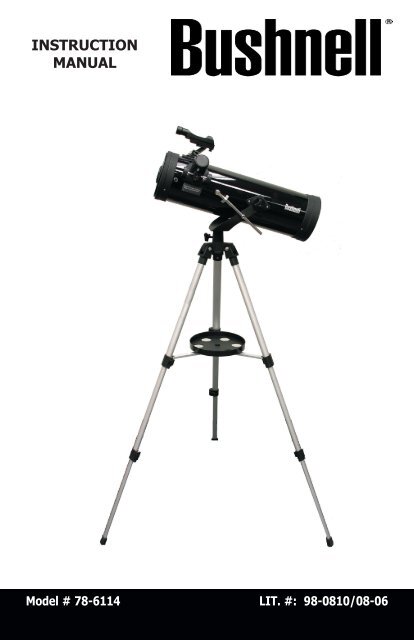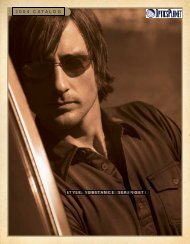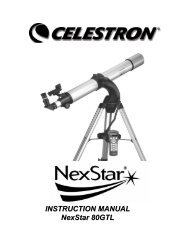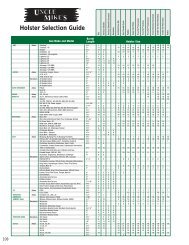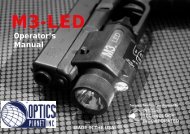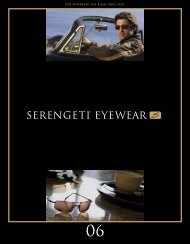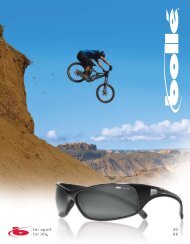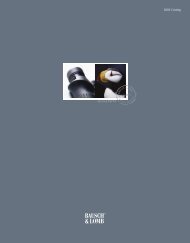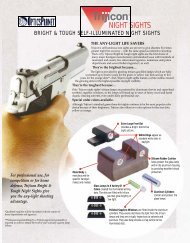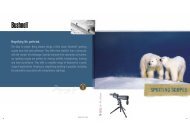Bushnell 4.5' Reflector Altaz Short Tube Telescope - OpticsPlanet.com
Bushnell 4.5' Reflector Altaz Short Tube Telescope - OpticsPlanet.com
Bushnell 4.5' Reflector Altaz Short Tube Telescope - OpticsPlanet.com
Create successful ePaper yourself
Turn your PDF publications into a flip-book with our unique Google optimized e-Paper software.
INSTRUCTION<br />
MANUAL<br />
Model # 78-6114 LIT. #: 98-0810/08-06<br />
QVC 78-6114 <strong>Telescope</strong> 1LIM.indd 1 9/6/2006 3:02:21 PM
WHERE DO I START?<br />
Your <strong>Bushnell</strong> telescope can bring the wonders of the universe to your eye. While this manual is<br />
intended to assist you in the set-up and basic use of this instrument, it does not cover everything you<br />
might like to know about astronomy. It is re<strong>com</strong>mended you get a very simple star chart and a flashlight<br />
with a red bulb or red cellophane over the end. For objects other than stars and constellations,<br />
a basic guide to astronomy is a must. Some re<strong>com</strong>mended sources appear on our website at www.<br />
bushnell.<strong>com</strong>. Also on our website will be current events in the sky for suggested viewing. But, some<br />
of the standbys that you can see are:<br />
The Moon—a wonderful view of our lunar neighbor can be enjoyed with any magnification. Try viewing<br />
at different phases of the moon. Lunar highlands, lunar maria (lowlands called “seas” for their dark<br />
coloration), craters, ridges and mountains will astound you.<br />
Saturn—even at the lowest power you should be able to see Saturn’s rings and moons. This is one of<br />
the most satisfying objects in the sky to see simply because it looks like it does in pictures. Imagine<br />
seeing what you’ve seen in textbooks or NASA images from your backyard!<br />
Jupiter—the largest planet in our solar system is spectacular. Most noted features are its dark stripes<br />
or bands both above and below its equator. These are the north and south equatorial belts. Also interesting<br />
are Jupiter’s four major moons. Pay close attention to their positions from night to night. They<br />
appear to be lined up on either side of Jupiter.<br />
Mars—The Great Red Planet appears as a reddish-orange disk. Look at different times of the year<br />
and try to catch a glimpse of the white polar ice caps.<br />
Venus—just like the moon, Venus changes phases from month to month. At times Venus appears<br />
brilliantly in the night sky, just as if you were looking at a distant crescent moon.<br />
Nebulae—The Great Orion Nebula is a very well known night sky object. This and many others are<br />
brought to you by this telescope.<br />
Star Clusters—View millions of stars densely packed in a cluster that resembles a ball.<br />
Galaxies—One of the greatest and most interesting galaxies is our neighbor the Andromeda Galaxy.<br />
Enjoy this and many others.<br />
Other Resources:<br />
www.nasa.gov<br />
www.space.<strong>com</strong><br />
QVC 78-6114 <strong>Telescope</strong> 1LIM.indd 2 9/6/2006 3:02:21 PM
F<br />
I<br />
C<br />
PARTS DIAGRAM<br />
A<br />
M<br />
G<br />
P<br />
NOTE: Actual product may have improvements that are not shown in this diagram<br />
A. Yoke Mount G. Finderscope<br />
B. Focus Knob H. <strong>Telescope</strong> Main Body<br />
C. Focus <strong>Tube</strong> I. Tripod Leg<br />
D. Objective Mirror (not L. Yoke Locking Knob<br />
shown) M. Azimuth Lock<br />
E. Eyepiece O. Tripod Leg<br />
F. Dust Cap (remove Adjusting Clamp<br />
before viewing) P. Accessory Tray<br />
QVC 78-6114 <strong>Telescope</strong> 1LIM.indd 3 9/6/2006 3:02:23 PM<br />
E<br />
B<br />
L<br />
L<br />
D<br />
H<br />
O
1.<br />
3.<br />
ASSEMBLY DIAGRAMS<br />
2.<br />
4.<br />
CAUTION! Viewing the sun can cause permanent eye damage.<br />
Do not view the sun with this telescope or even with the naked eye.<br />
QVC 78-6114 <strong>Telescope</strong> 1LIM.indd 4 9/6/2006 3:02:25 PM<br />
5.
TELESCOPE ASSEMBLY INSTRUCTIONS<br />
1. Your telescope has adjustable (telescoping) legs (Fig. 1).<br />
2. Stand tripod and spread legs. Loosen the three leg clamps. Grab tripod head and lift.<br />
Extend the tripod legs to the desired height (at equal lengths) and tighten the clamps<br />
on each leg to hold it in position (Fig. 1). Note: please tighten tripod head bolts after<br />
removing from box, as some vibration during shipment may have loosened them.<br />
3. Attach the accessory tray (P) to the center leg braces on the tripod legs (Fig 2) and<br />
insert accessory tray and bolt through center of tray into braces and tighten bolt.<br />
4. Remove telescope main body from the box. Attach telescope main body (H) by aligning<br />
the hole in the telescope saddle with that in the yoke. Screw yoke locking knobs (L)<br />
through both holes and tighten the knob.<br />
5. Remove the finderscope (G) from the box. Remove the two knurled thumbscrews from<br />
the telescope main body. Position the finderscope bracket on the telescope main body so<br />
that the holes in the base of the bracket line up with the exposed bolts in the telescope<br />
main body. Replace the two-knurled thumbscrews and tighten securely (Fig. 3).<br />
6. Insert eyepiece (E) into focus tube (C). Secure by tightening small retaining screw.<br />
NOTE: In all astronomical telescopes, the image appears upside down. To use the<br />
telescope for terrestrial view and to correct the mirrored image, insert the erecting<br />
eyepiece in between the focus tube (C) and the eyepiece (E). We re<strong>com</strong>mend the use<br />
of the low magnification eyepiece when the telescope is used for terrestrial viewing.<br />
<strong>Reflector</strong>s (mirrors) are used mainly for astronomical purposes.<br />
The telescope is now fully assembled and ready for use.<br />
7. To use the Barlow, insert Barlow (Fig. 5) into the focus tube. Secure by tightening small<br />
retaining screw. Insert eyepiece into open end of Barlow and secure.<br />
8. To use the erecting lens, insert erecting lens (Fig. 5) into the focus tube. Secure by<br />
tightening small retaining screw. Insert eyepiece into the open end of the erecting lens<br />
and secure. This will allow you to view objects naturally on land—not upside down or<br />
backwards.<br />
TO USE THE FINDERSCOPE<br />
The finderscope is a small wide field of view telescope mounted alongside the main<br />
telescope and is used to search for the target and aim the main telescope at it. But before<br />
you can use the finderscope, you will need to line it up with the telescope. This procedure<br />
will be<strong>com</strong>e easier with practice.<br />
1. Install the lowest power eyepiece (25mm) into the eyepiece tube. Pick out an easily<br />
recognized, unmoving object no closer than a thousand yards away. Aim your telescope<br />
toward your object until its image is centered in the eyepiece. Lock all the knobs on the<br />
mount so the telescope will not move.<br />
2. Look through the finderscope. If the object you lined up in the telescope is not visible,<br />
adjust the two adjustment screws and move the finderscope around until you see it.<br />
3. Recheck your telescope to make certain it is still on target. If it moved, realign it and<br />
adjust your finderscope. If it hasn’t, you’re all set. Your finderscope is now operational.<br />
QVC 78-6114 <strong>Telescope</strong> 1LIM.indd 5 9/6/2006 3:02:26 PM
FINDING OBJECTS<br />
1. Loosen the altitude locks on the sides of the telescope tube and the silver azimuth lock on the<br />
base of the altazimuth mount, then move the telescope in the desired direction.<br />
2. Look through the finderscope and pan the telescope until the object appears in the field of view.<br />
Once it's in the field of view, tighten the altitude and azimuth locks.<br />
FOCUSING<br />
1. Once you have found an object in the telescope, turn the focus knob until the image is sharp.<br />
2. To focus on an object that is nearer than your current target, turn the focusing knob toward the<br />
eyepiece (i.e., so that the focus tube moves away from the front of the telescope). For more<br />
distant objects, turn the focus knob in the opposite direction.<br />
3. To achieve a truly sharp focus, never look through glass windows or across objects that produce<br />
heat waves, such as asphalt parking lots.<br />
MAGNIFICATION<br />
1. The magnification (or power) of a telescope varies depending upon the focal length of the<br />
eyepiece being used and the focal length of the telescope.<br />
2. To calculate magnification, use the following formula, in which FL = focal length:<br />
Magnification = FL (telescope) in mm<br />
FL (eyepiece)<br />
TECHNICAL SPECIFICATIONS<br />
Objective Diameter: 114mm (4.5”)<br />
Focal Length: 500mm<br />
Eyepieces: H20mm (Low Power)<br />
H12.5mm (High Power)<br />
Erecting Eyepiece: 1.5X<br />
Barlow: 3X<br />
Maximum Magnification: 120X<br />
Accessories: Finderscope, moon<br />
map, astronomy CD<br />
EYE LENS CHART & THEORETICAL POWER LIMITS<br />
H12.5mm Eye Lens Power: 40X<br />
H20mm Eye Lens Power: 25X<br />
NOTE: Magnification is calculated magnification.<br />
Low power is re<strong>com</strong>mended for most viewing conditions.<br />
QVC 78-6114 <strong>Telescope</strong> 1LIM.indd 6 9/6/2006 3:02:26 PM
ENJOYING YOUR NEW TELESCOPE<br />
1. First determine your targeted object. Any bright object in the night sky is a good starting point<br />
One of the favorite starting points in astronomy is the moon. This is an object sure to please any<br />
budding astronomer or experienced veteran. When you have developed proficiency at this level,<br />
other objects be<strong>com</strong>e good targets. Saturn, Mars, Jupiter, and Venus are good second steps<br />
to take.<br />
2. The first thing you need to do after assembling the telescope as planned is center the desired object<br />
in the finderscope. Provided you did a reasonable job aligning the finderscope, a quick<br />
look through the main telescope tube at low power should reveal the same image. With the lowest<br />
power eyepiece (the one with the largest number printed on it) you should be able to focus the<br />
same image that you saw through the finderscope. Avoid the temptation to move directly to the<br />
highest power. The low power eyepiece will give you a wider field of view, and brighter image—thus<br />
making it very easy to find your target object. At this point with a focused image in both scopes,<br />
you’ve passed the first obstacle. If you don’t see an image after attempting to focus it in, you<br />
might consider aligning your finderscope again. Once you pass this step, you’ll will enjoy the time<br />
spent ensuring a good alignment. Every object you center in the finderscope will be easily found in<br />
the main telescope tube, which is important for continuing your exploration of the night sky.<br />
3. The low power eyepieces are perfect for viewing the full moon, planets, star clusters, nebulae, and<br />
even constellations. These should build your foundation. However, for more detail, try bumping<br />
up in magnification to higher power eyepieces on some of these objects. During calm and crisp<br />
nights, the light/dark separation line on the moon (called the “Terminator”) is marvelous at high<br />
power. You can see mountains, ridges and craters jump out at you due to the highlights. Similarly,<br />
you can move up to higher magnifications on the planets and nebulae. Star clusters and individual<br />
stars are best viewed through the low power no matter what.<br />
4. The recurring astronomical theater we call the night sky is an ever-changing billboard. In other<br />
words, the same movie does not play all the time. Rather, the positions of the stars change not<br />
only hourly as they seem to rise and set, but also throughout the year. As the earth orbits the<br />
sun, our perspective on the stars changes on a yearly cycle about that orbit. The reason the<br />
sky seems to move daily just as the sun and the moon "move across our sky is that the earth<br />
is rotating about its axis. As a result you may notice that after a few minutes or a few seconds<br />
depending on what power your are viewing at, the objects in your telescope will move. At<br />
higher magnifications especially, you will notice that the moon or Jupiter will :race: right out of<br />
the field of view. To <strong>com</strong>pensate, just move your telescope to "track" it in the necessary path.<br />
QVC 78-6114 <strong>Telescope</strong> 1LIM.indd 7 9/6/2006 3:02:26 PM
HELPFUL HINTS<br />
1. Your telescope is a very sensitive instrument. For best results and<br />
fewer vibrations set your telescope up on a level location on the<br />
ground rather than your concrete driveway or your wooden deck. This<br />
will provide a more stable foundation for viewing, especially if you’ve<br />
drawn a crowd with your new telescope.<br />
2. If possible, view from a location that has relatively few lights. This will<br />
allow you to see much fainter objects. You’d be surprised how much<br />
more you’ll see from your local lake or park when <strong>com</strong>pared to a<br />
backyard in the city.<br />
3. Using your telescope out a window is NEVER re<strong>com</strong>mended.<br />
4. View objects that are high in the sky if possible. Waiting until the<br />
object rises well above the horizon will provide a brighter and crisper<br />
image. Objects on the horizon are viewed through several layers of<br />
earth’s atmosphere. Ever wonder why the moon appears orange as it<br />
sets on the horizon? It’s because you are looking through a considerable<br />
more amount of atmosphere than you would directly overhead.<br />
(Note: If objects high in the sky are distorted or wavy, you are probably<br />
viewing on a very humid night.) During nights of unstable atmosphere,<br />
viewing through a telescope can be frustrating if not impossible.<br />
Astronomers refer to crisp, clear nights as nights of “good seeing.”<br />
Customer Service (800) 423-3537<br />
©2006 <strong>Bushnell</strong> Outdoor Products<br />
www.bushnell.<strong>com</strong><br />
QVC 78-6114 <strong>Telescope</strong> 1LIM.indd 8 9/6/2006 3:02:27 PM
TELESCOPE LIFETIME LIMITED WARRANTY<br />
Your <strong>Bushnell</strong>® telescope is warranted to be free of defects in materials and workmanship for the lifetime of<br />
the original owner. The Lifetime Limited Warranty is an expression of our confidence in the materials and<br />
mechanical workmanship of our products and is your assurance of a lifetime of dependable service.<br />
If your telescope contains electrical <strong>com</strong>ponents, these <strong>com</strong>ponents are warranted to be free of defects in<br />
materials and workmanship for two years after the date of purchase.<br />
In the event of a defect under this warranty, we will, at our option, repair or replace the product, provided<br />
that you return the product postage prepaid. This warranty does not cover damages caused by misuse,<br />
improper handling, installation, or maintenance provided by someone other than a <strong>Bushnell</strong> Authorized<br />
Service Department.<br />
Any return made under this warranty must be ac<strong>com</strong>panied by the items listed below:<br />
1) A check/money order in the amount of $15.00 to cover<br />
the cost of postage and handling<br />
2) Name and address for product return<br />
3) An explanation of the defect<br />
4) Proof of Date Purchased<br />
5) Product should be well packed in a sturdy outside shipping carton, to prevent<br />
damage in transit, with return postage prepaid to the address listed below:<br />
IN U.S.A. Send To: IN CANADA Send To:<br />
<strong>Bushnell</strong> Outdoor Products <strong>Bushnell</strong> Outdoor Products<br />
Attn.: Repairs Attn.: Repairs<br />
8500 Marshall Drive 25A East Pearce Street, Unit 1<br />
Lenexa, Kansas 66214 Richmond Hill, Ontario L4B 2M9<br />
For products purchased outside the United States or Canada please contact your local dealer for applicable<br />
warranty information. In Europe you may also contact <strong>Bushnell</strong> at:<br />
BUSHNELL Outdoor Products Gmbh<br />
European Service Centre<br />
MORSESTRASSE 4<br />
D- 50769 KÖLN<br />
GERMANY<br />
Tél: +49 (0) 221 709 939 3<br />
Fax: +49 (0) 221 709 939 8<br />
This warranty gives you specific legal rights.<br />
You may have other rights which vary from country to country.<br />
©2006 <strong>Bushnell</strong> Outdoor Products<br />
QVC 78-6114 <strong>Telescope</strong> 1LIM.indd 9 9/6/2006 3:02:27 PM


